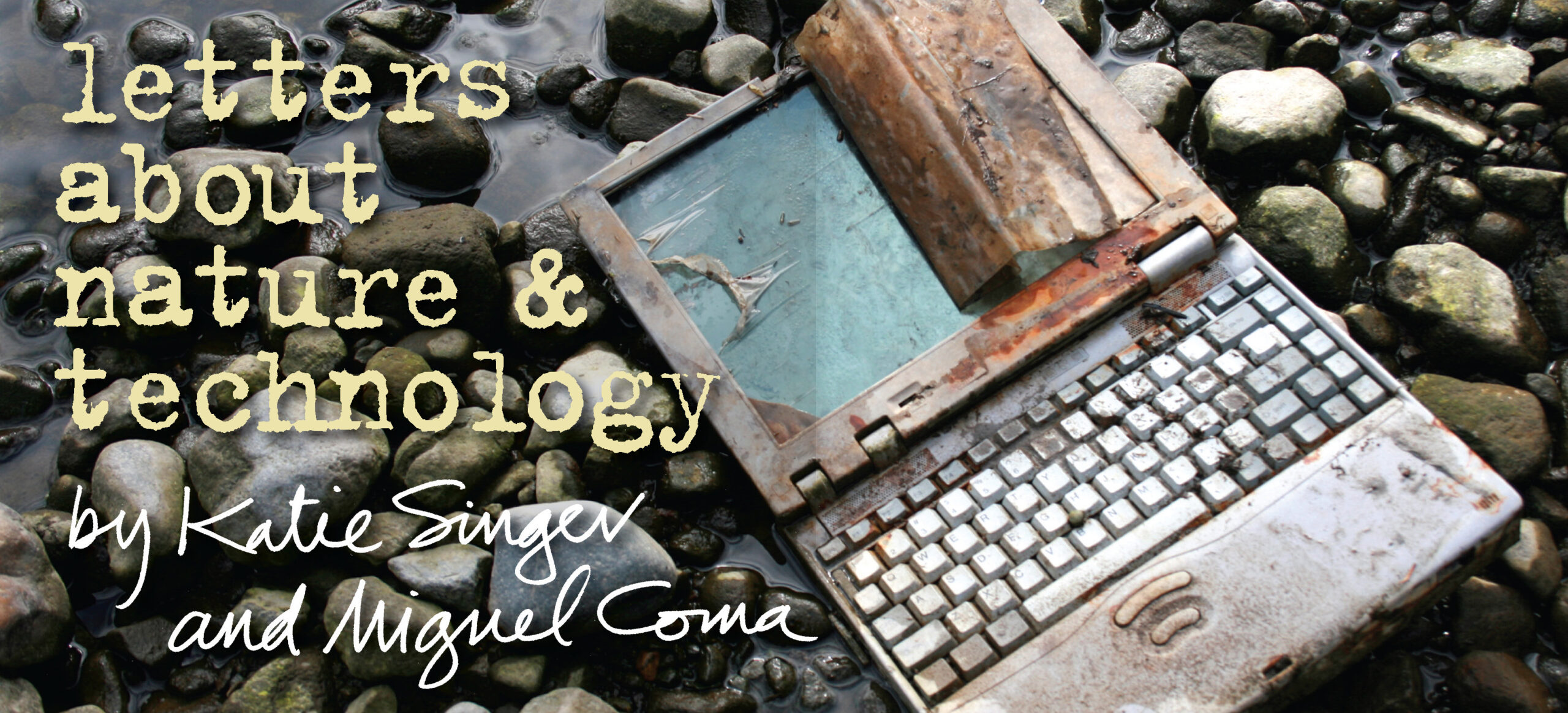Industrial-scale intermittent wind power:
recognizing its unreliability before we spend billions
a column about nature and technology
by Katie Singer
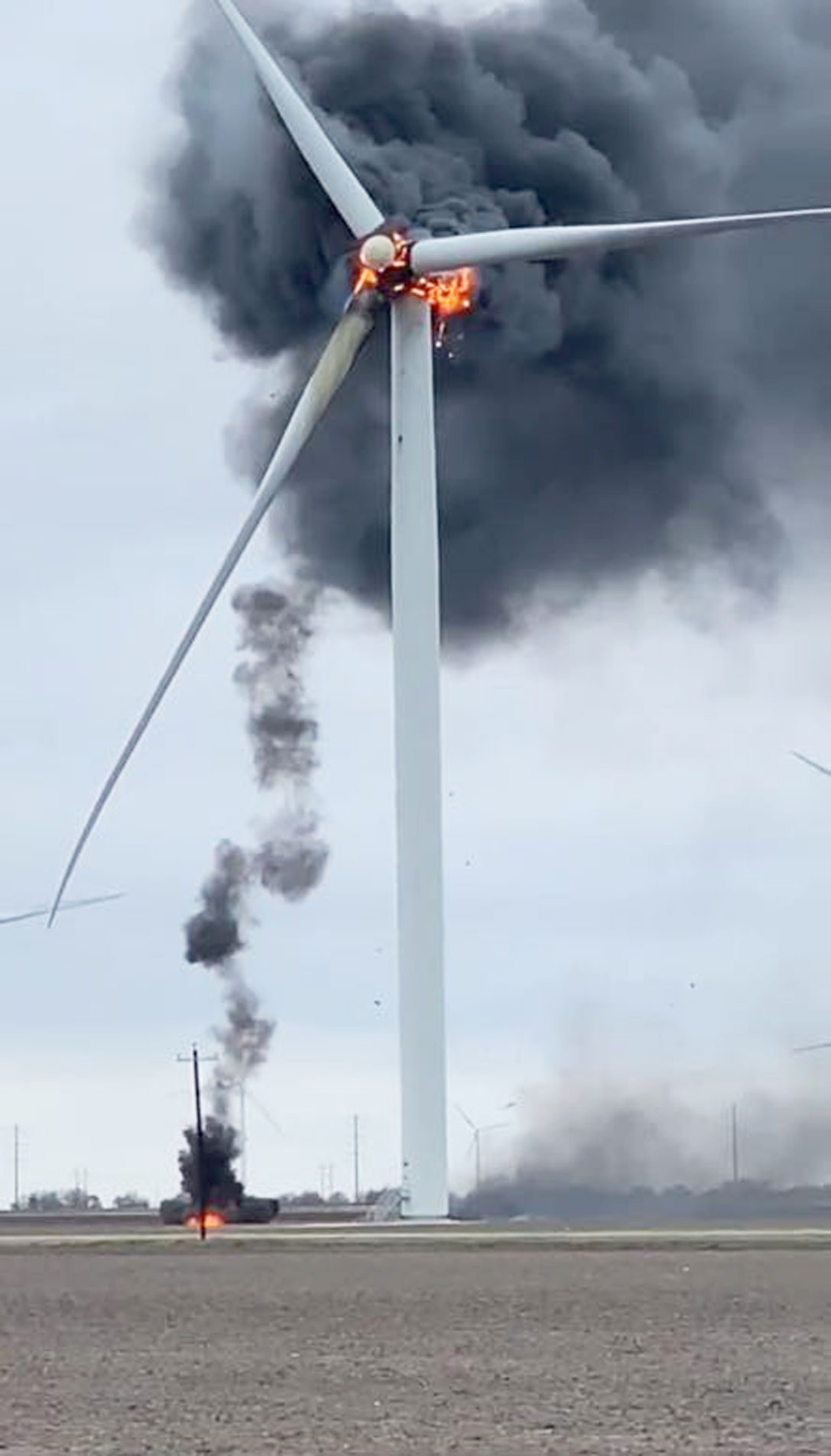
Wind turbine fire, Taft, Texas, USA, March, 2020. Photo credit News of San Patricio.
Call this an open letter to President Biden. To begin, let me appreciate that your American Jobs Plan recognizes connections between our economy, energy needs, greenhouse gas emissions and infrastructure. I am a citizen-researcher and writer, deeply concerned about life on Earth, eager for comprehensive, due diligent evaluations of alternative energy before we commit billions to their development.
I recognize that our society depends on safe, reliable, and affordable electric power, and that to reduce our global climate impacts, we need to reduce our greenhouse gas emissions, drastically.
Industrial wind facilities are now the country’s fastest-growing energy source. Proponents claim that wind energy is “green,” “clean,” “zero-emitting”—and that it will improve host communities’ economies.
To initiate a due diligent evaluation or industrial wind turbines (IWTs), let’s ask: Are these claims true? What are industrial wind turbines’ (IWTs’) unintended consequences?
To answer these questions, we’ll need people who are not industry lobbyists to evaluate wind turbines from their cradles to their graves. We’ll need to learn about the rare earth elements extracted for turbines. Consider studies about IWTs’ impacts on climate. Hear from folks who’ve lived near an industrial wind facility. Read about IWTs’ impacts on wildlife and farming. Learn how IWT installations impact local economies and what happens to wind turbines at the end of their usable lives. Then, legislators can make informed votes about whether or not to spend billions on wind energy.
The parts
A wind turbine includes the tower, a foundation, blades and a nacelle. (The nacelle holds the gearbox, which rotates and generates energy, then converts it into electricity.) These four parts contain more than 8000 different components, many of which are made from steel, cast iron, concrete and rare earth elements. [1] When turbines are installed offshore in deep water, their platforms also may require cables that anchor them to the seabed.
Turbines require lubrication. On average, a 5-MW (megawatt) turbine holds 700 gallons of oil and hydraulic fluid; like car oil, these need replacing every nine to 16 months. [2]
When the industry claims that a 5-MW wind facility can power 3200 homes, it usually omits the word “intermittently.” Because wind blows intermittently, IWTs cannot provide uninterrupted, reliable power to a single home, hospital, smelter, factory, data center, 4G cellular site, 5G cellular site, [3] or bitcoin mine 24/7, 365 days each year. IWTs need continuous backup power available 100% of the time. Usually, natural (fracked) gas, a fossil fuel we aim to reduce, provides backup to wind energy. When Texas temperatures froze last February, so did the turbines. Utilities did not have sufficient natural gas backup to keep electricity available.
To avoid repeating that failure, let’s recognize every wind complex typically requires wind+gas. Let’s also recognize studies that show wind+gas packages can produce more CO2 than gas alone. [4]
Manufacturing
Mostly, a wind turbine’s tower, nacelle and foundation are made of steel and concrete. Every ton of steel produced emits about 1.85 tons of CO2. In 2018, this amounted to eight percent of global emissions. Steel production generates wastewater containing cyanide, sulfides, ammonium, ammonia and other carcinogenic organic compounds. How can we call such toxic stuff “clean?” [5]
In a 5-MW turbine, the tower weighs about 400 tons (363 metric tons), the nacelle 300 tons (272 metric tons), and the three blades can total 54 tons (49 metric tons; 108,000 pounds). The foundation weighs several thousand tons. An offshore foundation can weigh between 500 and 8,000+ tons. [6]
Blades are made of wood, fiberglass and carbon fiber (petroleum-based plastics).
Nacelles contain dysprosium and neodymium (magnets) and other rare earth elements. A 2-MW wind turbine contains about 800 pounds of neodymium and 130 pounds of dysprosium. At least 75% of the rare earth market is controlled by China, which has little if any environmental regulations. Why would we invest in infrastructure that depends on an international supply chain? [7]
Neodymium and dysprosium are mined primarily in Baotou, China. This region was once organic farmland. Now it is a wasteland. According to the Institute for the Analysis of Global Security, mining one ton of rare earths produces about one ton of radioactive waste. Baotou’s lake’s radiation levels are ten times higher than in countryside lakes.
In 2012, the U.S. added 13,131 MW of wind generating capacity. MIT researchers estimate that this meant using between five and six million pounds of rare earths—and thereby producing between five and six million pounds of radioactive waste. (The U.S. nuclear industry annually produces between 4.4 and 5 million pounds of spent nuclear fuel.) [8]
People near Baotou report that they began to observe mining’s consequences in 1979. Animals’ front teeth grew too large for them to close their jaws, and livestock died from starvation. Farmers teeth changed, too. Men suffered bone cracks and fractures just by walking. [9] Severe skin and respiratory diseases became common. Children were born with soft bones, and cancer rates rocketed. [10]
Wind industry growth from 2012 to 2037 could raise demand for neodymium by as much as 700%, and 2600% for dysprosium. [11]
President Biden, with all due respect, I do not see how anyone can call IWTs “green” or “clean.”
Transporting and building turbines
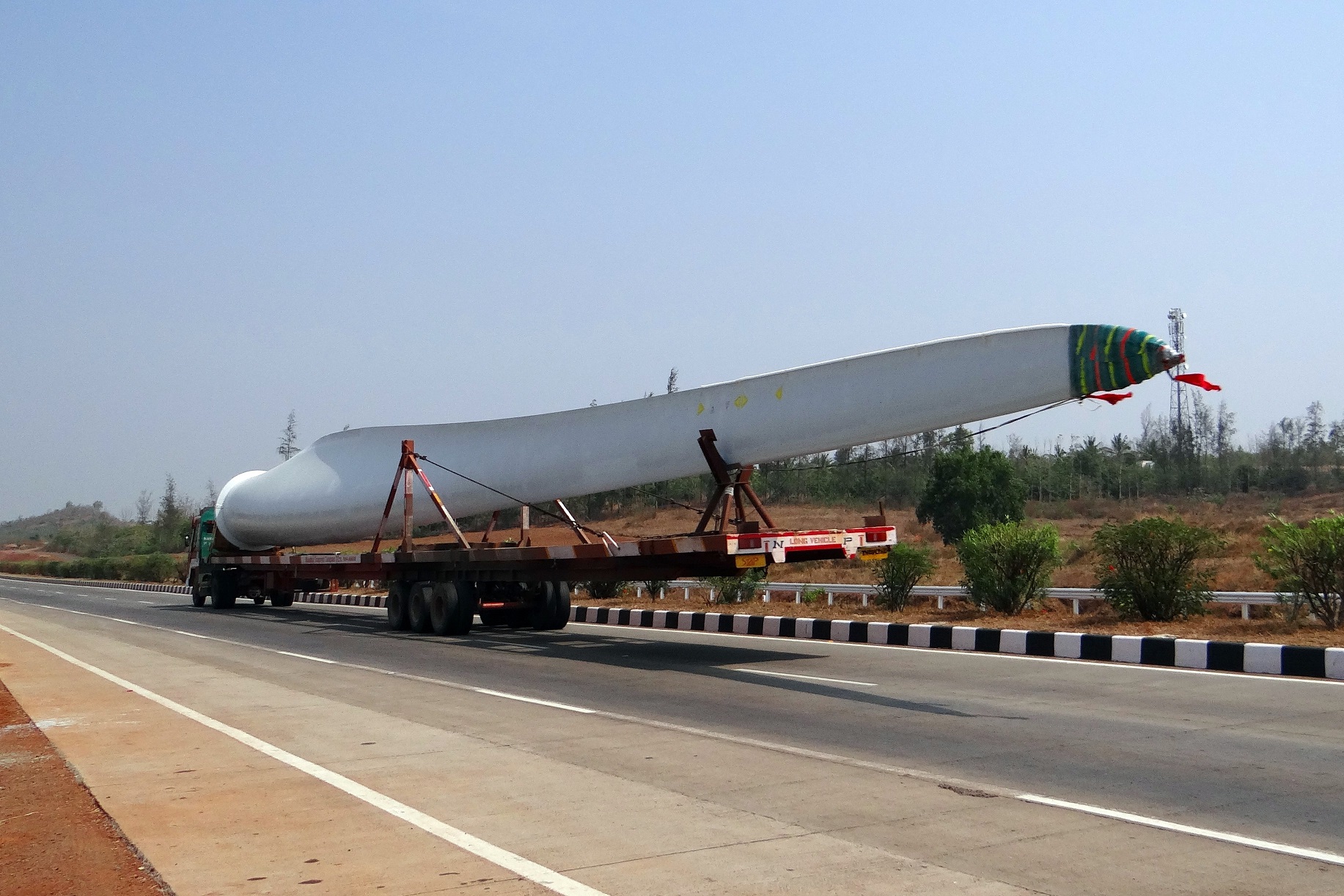
Transporting and building wind turbines is energy intensive and accident-prone.
Turbines are about 422 feet tall (40 stories, 12.2 meters). With each blade 300 feet (91.44 meters) long and weighing 22,000 pounds (9979 kilos), transporting them (typically from China) consumes significant energy. It also causes accidents: turbine sections have rammed through a house, knocked a utility pole through a restaurant, and fallen off of trucks. [12]
The base for each turbine has about two million pounds of concrete. Transporting this much cement and other raw materials into a (typically rural) area can damage village roads, which are not designed to bear this much weight, repeatedly. A 150 MW wind farm can require as many as 650 truckloads, 140 railcars, and eight ships. [13] When corporations leave the site without repairing roads, villages are left with infrastructure damages that they can’t afford to repair. [14]
There’s another issue here. Manufacturing every ton of concrete generates one ton of CO2. [15]
IWTs increase global warming
Because manufacturing industrial wind turbines’ concrete and steel—and smelting their rare earths—generates greenhouse gases, we cannot call IWTs “near carbon-neutral zero-emitters.”
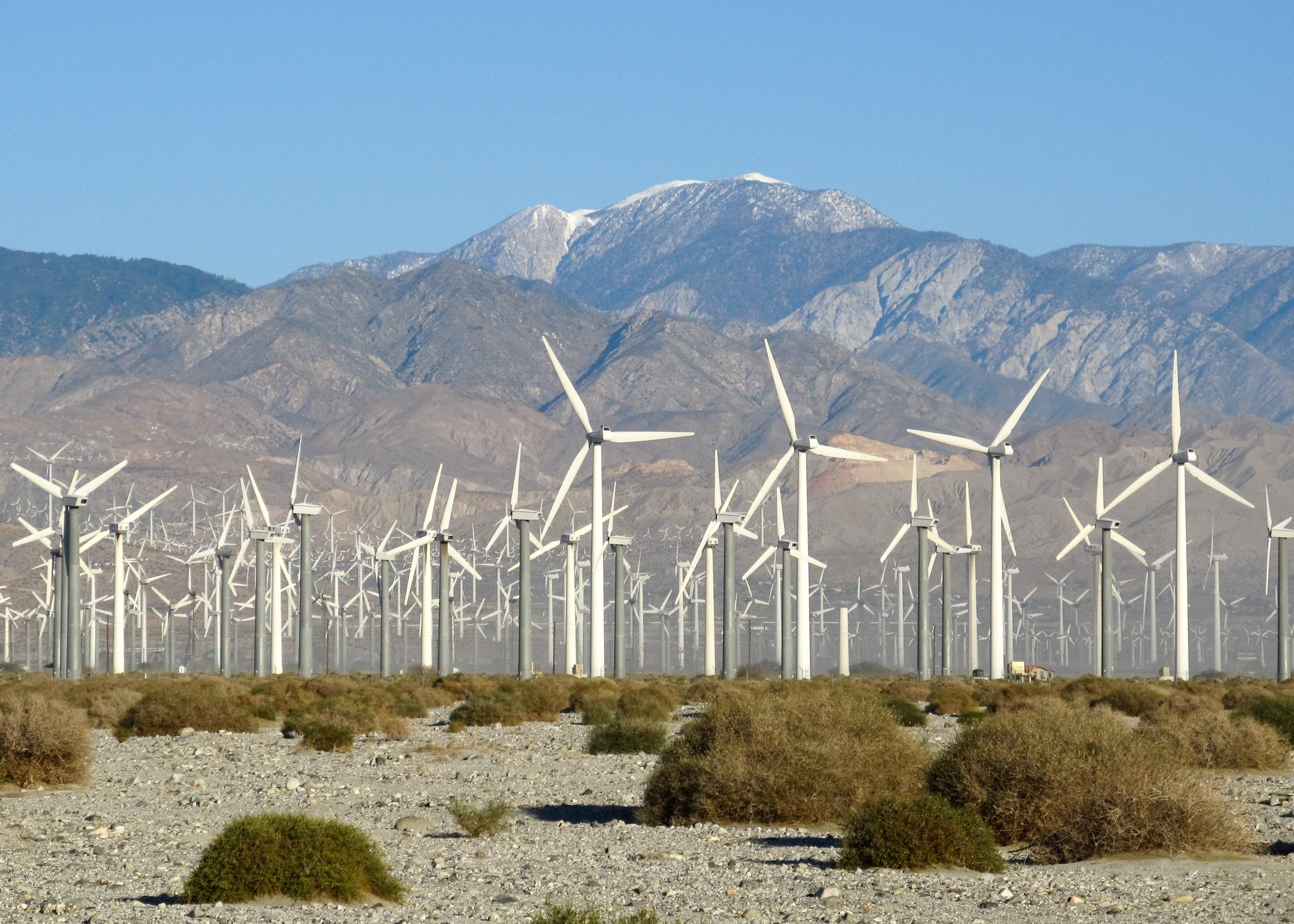
Industrial wind turbine facilities contribute to climate change. Photo credit Ken Lund
But also, IWTs warm global temperatures by redistributing heat. While wind power’s overall environmental impacts are less than fossil fuels, it “does cause non-negligible climatic impacts.” [16] Modeling suggests that deploying land-based IWTs to meet about 10% of 2100’s world energy needs could lead to a significant temperature increase in the lower atmosphere where turbines are installed. While offshore IWTs do not impact global climate significantly (compared to land-based installations), offshore intermittency is substantial. In any case, to provide a fraction of our estimated future energy needs, we’d need to deploy several million wind turbines. [17]
In other words, wind energy can’t solve our climate problem.
IWTs depend on backup power
As wind surges and ebbs, utilities must balance electricity demands with supply to avoid brownouts, blackouts and overloads. Balancing a wind+gas package produces CO2. When coal is used to backup wind, more nitrogen oxides and sulfur oxides are produced. [18]
Again, the Texas grid’s failure was caused by a combination of incapacitated wind turbines—and insufficient gas backup. [19]
IWT impacts on human health
Whenever there’s wind, turning blades produce constant, disturbing noise, vibration and “shadow flicker” within nearby homes and buildings. People who live or work near IWTs have experienced decreased quality of life, sleep disturbance, anxiety, headaches, depression, irritability, pressure on ear-drums, panic attacks, balance problems, sinus problems, erratic/high blood pressure, eye strain, nausea, cognitive dysfunction, and a sense of injustice. [20] Even a mile or two away, IWTs can disturb (prevent) sleep.
Countless people have abandoned their homes and lost everything they had after turbines were installed near their properties. [21]
On wildlife

Farmer with dead eagle after wind turbine injury, near Waterloo Wind Farm, Australia. Photo by Vanessa Hunter.
Industrial wind turbines impact wildlife by causing habitat loss (reduced nesting densities, loss of grasslands, increased nest parasitism and predation), and impacts on water quality. As IWTs increase, so do wildlife deaths. By 2012, IWTs caused an estimated 573,000 bird deaths, of which some 83,000 were raptors. [22]
In 2012, IWTs killed at least 888,000 insectivorous bats—based on 51,630 MW of installed wind capacity. Bats are killed by blade collisions and barotrauma (changes in air pressure). [23] A bat can eat 1000 insects per hour. When bat populations decrease, insect populations increase. Crop yields decrease. So can human health. [24]
Blades fail
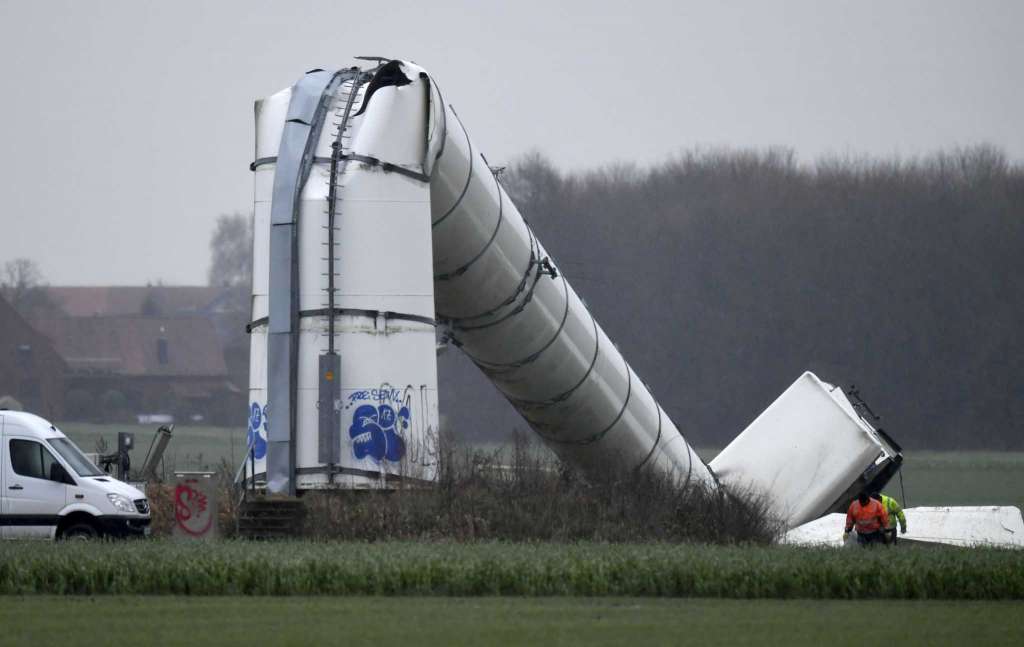
After the rotor broke, a 70-meter wind turbine collapsed, January, 2018, near Hanover, Germany.
Turbines have thrown whole or parts of blades as much as one mile (1.6 km). Hurled blades can cut through roofs and walls of nearby structures. (Should regulators require a minimum of 1.2 miles (2 kms) between turbines and residences, schools and work places?) [25]
Fire hazards
Every industrial wind facility can expect one to two fires during its operational lifetime. One turbine fire can cost $4.5 million. Because turbines are so tall, firefighters can do little but watch fires burn themselves out. In stormy or dry weather, risks increase. Turbines fling burning debris, endangering people, wildlife and nearby property. [26]
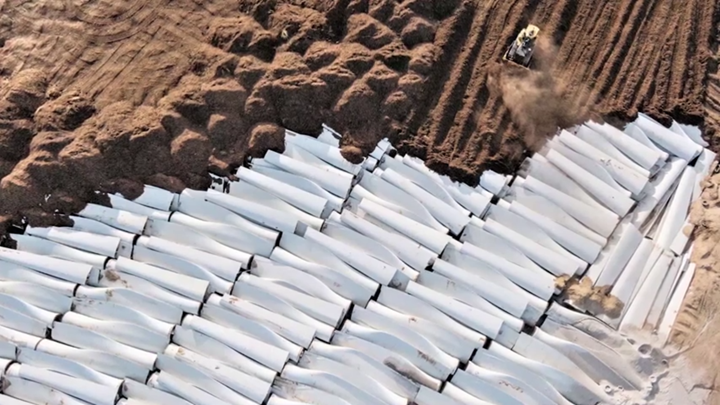
At the end of their lifecycle, wind turbines do not biodegrade.
End of usable life
Wind turbines do not biodegrade. To date, there’s no way to recycle the blades when their usable life (typically 10 – 20 years) ends. One wind facility may have 90 turbines, each with three blades. What are the long-term ecological impacts of burying thousands of (oil-coated?) wind turbine blades, each weighing 22,000 pounds? [27]
If an IWT facility is proposed in your area
President Biden, given your plans for developing industrial wind turbine facilities around the U.S. (and European politicians have similar plans), I want common citizens to know about the Alliance for Wise Energy Decisions, www.wiseenergy.org. “The Basic Steps to Winning an Onshore Local Wind War” includes a model report for any town to estimate the net annual financial impact of a proposed wind project. With installation of an IWT complex, municipalities can expect substantial losses in agriculture (from lost bats and weather changes), property devaluation and reduced tourism—as well as adverse effects to health, wildlife, drinking water and wells. May this report help local legislators see IWTs’ sobering economic impacts. [28]
For wind turbine accident data, visit the Caithness Windfarm information Forum 2020. http://www.caithness.windfarms.co.uk
Sir, to inform yourself and Congress members about IWT hazards, could you host a film series? I recommend Laura Israel’s “Windfall” and Jeff Gibbs and Michael Moore’s “Planet of the Humans.” Julia Barnes’ “Bright Green Lies” will premier April 22nd. [29]
New designs
New industrial-scaled wind designs include “floating” turbines. One proposal would install 50 industrial wind turbines in Lake Erie. Decades ago, steel mills and other factories dumped so much toxic waste into Lake Eric that it caught fire. How will 50 industrial turbines affect the lake’s marine life—and 11 million people’s water supply?
“Bladeless” turbines claim to provide bird safety. [30]
I still wonder: do professional engineers conduct due diligent evaluations on industrial wind turbines?
Moving forward
Greenwashing our dependence on electricity and the fact that every fuel source—including wind and solar photovoltaics [31]—has harmful consequences does not reduce those consequences. Who benefits when we call wind “clean” and “carbon neutral?” Who benefits when legislators vote on spending billions on industrial wind without due diligent evaluations? With due diligence on our table, what solutions (to energy demands, climate chaos and biodiversity loss) could emerge? [32]
ENDNOTES
1. https://www.instituteforenergyresearch.org/renewable/wind/big-winds-dirty-little-secret-rare-earth-minerals/
2. “Energy portfolio diversification,” ExxonMobil Fuels & Lubricants. Lesinski, “Synthetics to Protect the Wind Turbine and the Environment,” Wind Systems Magazine, January 2013.
3. Ben Ishai, Paul, “The Green Dilemma of 5G Densification,” April 3, 2021. https://blogs.timesofisrael.com/the-green-dilemma-of-5g-densification/
4. http://wiseenergy.org/Energy/Wind_Other/Wind_&_AGW_Full.pdf
5. https://www.theguardian.com/cities/2019/feb/25/concrete-the-most-destructive-material-on-earth
6. “Repower 5M,” Database of turbines and manufacturers, The Windpower Wind Energy Market Intelligence. https://www.thewindpower.net/turbine_en_14_repower_5m.php
7. Lee, Jordy and Morgan Bazilli, “The U.S. is worried about its critical minerals supply chains—essential for electric vehicles, wind power and the nation’s defense,” The Conversation, April 6, 2021.
8. https://www.nei.org/resources/statistics
9. https://www.marketwatch.com/story/a-tale-of-chinese-dwellers-in-a-degraded-land-2013-03-04
10. Maughan, Tim, “The dystopian lake filled by the world’s tech lust,” BBC Future, April 2, 2015. https://www.bbc.com/future/article/20150402-the-worst-place-on-earth
https://www.instituteforenergyresearch.org/renewable/wind/big-winds-dirty-little-secret-rare-earth-minerals/
11. Alonso, Elisa, et al., “Evaluating Rare Earth Availability: A Case with Revolutionary Demand from Clean Technologies,” Env. Sci. & Tech., 2012. http://www.rareearthassociation.org/MIT-Ford%20Study.pdf
12. http://www.caithnesswindfarms.co.uk/AccidentStatistics.htm
13. https://www.lockheedmartin.com/content/dam/lockheed-martin/eo/documents/webt/transporting-wind-turbine-blades.pdf
14. See Laura Israel’s 2009 documentary, “Windfall.”
15. https://www.greenconcrete.info/downloads/11_ConcreteCO2.pdf
16. Miller, Lee M. and David W. Keith, “Climatic Impacts of Wind Power,” Joule, 2018. https://doi.org/10.1016/joule.2018.09.009
17. https://iopscience.iop.org/article/10.1088/1748-9326/6/2/025101
Wang, Chien and Ronald G. Prinn, “Potential climatic impacts and reliability of large-scale offshore wind farms, Env. Research, 22 June 2011.
18. https://energycentral.com/c/ec/wind-energy-does-little-reduce-co2-emissions
19. Linyue Gao, et al., “A field study of ice accretion and its effects on the power production of utility-scale wind turbines,” Renewable Energy, vol. 167 April 2021.
20. https://www.ncbi.nlm.nih.gov/pmc/articles/PMC3653647/
https://waubrafoundation.org.au/wp-content/uploads/2013/02/Thorne_Wind-farm-generated-noise-adverse-health-effects.pdf
21. https://www.facebook.com/groups/740453565984169
22. Smallwood, K. Shawn, “Comparing bird and bat fatality-rate estimates among North American wind-energy projects,” Wildlife Society, 26 March 2013; https://doi.org/10.1002/wsb.260.
23. ibid.
24. Manville II, Albert M., “Impacts to Birds and Bats Due to Collisions and Electrocutions from Some Tall Structures in the United States: Wires, Towers, Turbines, and Solar Arrays—State of the Art in Addressing the Problems,” Springer International Publishing, Switzerland 2016.
F.M. Angelici (ed.), Problematic Wildlife: A Cross-Disciplinary Approach, Springer, 2016. https://tethys.pnnl.gov/publications/problematic-wildlife-cross-disciplinary-approach
25. http://www.caithnesswindfarms.co.uk/AccidentStatistics.htm
26. http://www.caithnesswindfarms.co.uk/AccidentStatistics.htm
https://www.windpowerengineering.com/the-true-cost-of-wind-turbine-fires-and-protection/
https://www.facebook.com/groups/740453565984169
27. https://www.npr.org/2019/09/10/759376113/unfurling-the-waste-problem-caused-by-wind-energy
Bloomberg, Chris Martin, “Wind turbine blades can’t be recycled, so they’re piling up in landfills,” Feb. 6, 2020. https://www.latimes.com/business/story/2020-02-06/wind-turbine-blades
28. http://wiseenergy.org/Energy/Wind_Economics/Wind_Net_Economics_Summary.pdf
29. https://www.wind-watch.org/video-windfall.php
www.planetofthehumans.com
30. https://www.engadget.com/2016-11-05-six-innovative-wind-turbine-designs.html
“Six innovative wind turbine designs: One of them is a bladeless design for bird safety,” Inhabit; 11.05.16.
31. www.ourweb.tech/letter-14/ www.ourweb.tech/letter-12/; www.ourweb.tech/letter-16/
32. For historical perspective on industrial wind, please see B. Blake Levitt’s op-ed, “What is the Real Risk/Benefit of Big Wind?” published April 6, 2011 in The Litchfield (CT) County Times. https://tinyurl.com/45eyhwdj
Katie Singer writes about the energy, extractions, toxic waste and greenhouse gases involved in manufacturing computers, telecom infrastructure, electric vehicles and other electronic technologies. She believes that if she’s not aware that she’s part of the problem, then she can’t be part of the solution. She dreams that every smartphone user learns about the supply chain of one substance (of 1000+) in a smartphone. Her most recent book is An Electronic Silent Spring. She currently writes about nature, democracy and technology for Meer.com. Visit www.OurWeb.tech and www.ElectronicSilentSpring.com.
This article was originally published by Meer.com.
